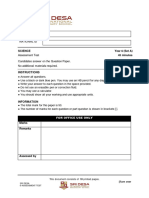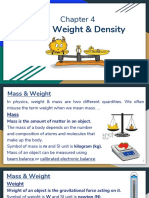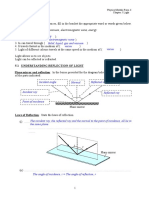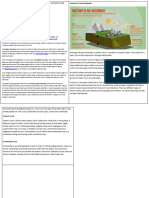The Structure of The Earth
The Structure of The Earth
Uploaded by
KishanCopyright:
Available Formats
The Structure of The Earth
The Structure of The Earth
Uploaded by
KishanOriginal Description:
Original Title
Copyright
Available Formats
Share this document
Did you find this document useful?
Is this content inappropriate?
Copyright:
Available Formats
The Structure of The Earth
The Structure of The Earth
Uploaded by
KishanCopyright:
Available Formats
The Structure of the Earth
The Earth consists of four concentric layers: inner core, outer core, mantle and crust. The crust is
made up of tectonic plates, which are in constant motion. Earthquakes and volcanoes are most
likely to occur at plate boundaries.
The structure of the Earth
The Earth is made up of four distinct layers:
The inner core is in the centre and is the hottest part of the Earth. It is solid and made up
of iron and nickel with temperatures of up to 5500°C. With its immense heat energy, the
inner core is like the engine room of the Earth.
The outer core is the layer surrounding the inner core. It is a liquid layer, also made up of
iron and nickel. It is still extremely hot, with temperatures similar to the inner core.
The mantle is the widest section of the Earth. It has a diameter of approximately 2900km.
The mantle is made up of semi-molten rock called magma. In the upper parts of the mantle
the rock is hard, but lower down the rock is soft and beginning to melt.
The crust is the outer layer of the earth. It is a thin layer between 0-60km thick. The crust is
the solid rock layer upon which we live.
There are two different types of crust: continental crust, which carries land, and oceanic crust,
which carries water.
Continental Crust vs Oceanic Crust
Continental crust is older than oceanic crust because oceanic crust is constantly being
destroyed
Continental crust is lighter (less dense) than oceanic crust
Continental crust is thicker (25km-75km) than oceanic crust (7km-10km)
The diagram below shows the structure of the earth. In geography, taking a slice through a
structure to see inside is called a cross section.
Cross section showing structure of the Earth
Distribution
The Earth's crust is broken up into pieces called plates. Heat rising and falling inside the mantle
creates convection currents generated by radioactive decay in the core. The convection currents
move the plates. Where convection currents diverge near the Earth's crust, plates move apart.
Where convection currents converge, plates move towards each other. The movement of the
plates, and the activity inside the Earth, is called plate tectonics.
Plate tectonics cause earthquakes and volcanoes. The point where two plates meet is called a
plate boundary. Earthquakes and volcanoes are most likely to occur either on or near plate
boundaries.
The Earth's plates move in different directions
Plates behave differently at different plate boundaries:
At a tensional, constructive or divergent boundary the plates move apart.
At a compressional, destructive or convergent boundary the plates move towards each
other.
At a conservative or transform boundary the plates slide past each other.
Different exam boards and textbooks may use different names for each of the boundary types. For
example, a destructive boundary may also be called a collision boundary. Use any term so long as
you use it correctly, but it is best to stick to the terms you have been taught.
Tensional margins
At a tensional or constructive boundary the plates are moving apart. The plates move apart due
to convection currents inside the Earth.
The Helgafjell volcano on Westman Island, Iceland
As the plates move apart (very slowly), magma rises from the mantle. The magma erupts to the
surface of the Earth. This is also accompanied by earthquakes.
When the magma reaches the surface, it cools and solidifies to form a new crust of igneous rock.
This process is repeated many times, over a long period of time.
Eventually the new rock builds up to form a volcano. Constructive boundaries tend to be found
under the sea, eg the Mid-Atlantic Ridge. Here, chains of underwater volcanoes have formed along
the plate boundary. One of these volcanoes may become so large that it erupts out of the sea to
form a volcanic island, eg Surtsey and the Westman Islands near Iceland.
The diagram below to see how magma pushes up between the two plates, causing a chain of
volcanoes along the constructive plate boundary.
Destructive / Compressional boundary
At a compressional or destructive boundary the plates are moving towards each other. This
usually involves a continental plate and an oceanic plate.
The oceanic plate is denser than the continental plate so, as they move together, the oceanic plate
is forced underneath the continental plate. The point at which this happens is called the
subduction zone. As the oceanic plate is forced below the continental plate it melts to form
magma and earthquakes are triggered. The magma collects to form a magma chamber. This
magma then rises up through cracks in the continental crust. As pressure builds up, a volcanic
eruption may occur.
A view of the Himalayas from Gorak Shep
Collision boundary
As the plates push together, the continental crust is squashed together and forced upwards. This is
called folding. The process of folding creates fold mountains. Fold mountains are formed where
two continental plates push towards each other. This is how mountain ranges such as the
Himalayas and the Alps were formed.
Fold mountains occur near convergent or compressional plate boundaries. Examples of fold
mountains include the Alps, Rockies, Andes and Himalayas.
Formation and characteristics
The formation of fold mountains
The formation of fold mountains
Where an area of sea separates two plates, sediments settle on the sea floor in
depressions called geosynclines. These sediments gradually become compressed into
sedimentary rock.
When the two plates move towards each other again, the layers of sedimentary rock on
the sea floor become crumpled and folded.
Eventually the sedimentary rock appears above sea level as a range of fold mountains.
Conservative boundary
When plates move along side each other in opposite directions or in the same direction but at
different speeds earthquakes are created.
The plate margins are made up of rock that is brittle and jagged so it is difficult for the plates to
slide past each other. Sometimes the plates get stuck and pressure builds and builds until
eventually they suddenly jerk forwards. This sudden movement and release of pressure is the
cause of earthquakes at this type of margin. The most famous conservative plate margin is the San
Andreas Fault on the western coast of North America.
You might also like
- Cambridge History Textbook Year 7Document17 pagesCambridge History Textbook Year 7thatrandomfellow39100% (1)
- Black Salve RecipeDocument24 pagesBlack Salve RecipePlainJenn100% (1)
- Sci - Y6 (Set A) - Assesment Test - 2023Document10 pagesSci - Y6 (Set A) - Assesment Test - 2023JK EduNotesNo ratings yet
- Science Yearly Lesson Plan Form 2Document10 pagesScience Yearly Lesson Plan Form 2NorelyanaAli100% (2)
- Grade 6 CirculatoryDocument32 pagesGrade 6 Circulatoryalvarez9654No ratings yet
- Magnet Grade 5 WSDocument7 pagesMagnet Grade 5 WSCatherine JeaneNo ratings yet
- Worksheet 1.1.bDocument4 pagesWorksheet 1.1.bMahay Haidr0% (1)
- Nebulae and Tectonic PlatesDocument4 pagesNebulae and Tectonic PlatesDeeva SethiNo ratings yet
- Science-The Earth-Moon-Sun-WorksheetDocument2 pagesScience-The Earth-Moon-Sun-WorksheetConistance Gatsi50% (2)
- Class 7 Geography Chapter 1 and 2Document3 pagesClass 7 Geography Chapter 1 and 2Ranjan RoyNo ratings yet
- HCF and LCMDocument8 pagesHCF and LCMilkayNo ratings yet
- Reflection.: - Complete The Questions BelowDocument4 pagesReflection.: - Complete The Questions BelowDuyBùiNo ratings yet
- Calculating-Angles Ver 2Document6 pagesCalculating-Angles Ver 2Khanh ChiNo ratings yet
- Cambridge IGCSE: English As A Second Language 0510/13Document16 pagesCambridge IGCSE: English As A Second Language 0510/13HaithamNo ratings yet
- Yr 7 Water Cycle Notes.Document2 pagesYr 7 Water Cycle Notes.abhay0% (1)
- Compound InterestDocument16 pagesCompound InterestRikky RosaNo ratings yet
- Grade 4 Maths Mid-Year AssessmentDocument6 pagesGrade 4 Maths Mid-Year Assessmentdawmaythetnwe12100% (1)
- Hands-On Science Workbook Primary 4 (Chapter 02)Document9 pagesHands-On Science Workbook Primary 4 (Chapter 02)Sheila YongNo ratings yet
- Year 3 Science Assessment Term 2Document2 pagesYear 3 Science Assessment Term 2nicole.vieira2100% (1)
- Igcse Extended Mathematics (0580) Topical Past Paper Questions - 2016/2017 Matrices and Transformations (Paper 4) 1Document8 pagesIgcse Extended Mathematics (0580) Topical Past Paper Questions - 2016/2017 Matrices and Transformations (Paper 4) 1HiNo ratings yet
- 4.mass, Weight & DensityDocument14 pages4.mass, Weight & DensityFaNo ratings yet
- Science - Energy Notes TeacherDocument2 pagesScience - Energy Notes Teacherapi-232744621No ratings yet
- Grade 6th Fun With Magnets ScienceDocument5 pagesGrade 6th Fun With Magnets Scienceredjasemk100% (1)
- Year 10 - End of Year ExamDocument13 pagesYear 10 - End of Year ExamsmakheleNo ratings yet
- CPS3 Endterm2 Unit 6Document3 pagesCPS3 Endterm2 Unit 6866cndhvhkNo ratings yet
- Mixed Percentages WorksheetDocument2 pagesMixed Percentages WorksheetjulucesNo ratings yet
- Maths Form 1 End TermDocument6 pagesMaths Form 1 End Termparmeet singh100% (1)
- Energy Stores PowerpointDocument16 pagesEnergy Stores PowerpointnowarabdullaaNo ratings yet
- Topical Test IndicesDocument2 pagesTopical Test IndicesNajiha MajidNo ratings yet
- Forces and MagnetismDocument41 pagesForces and MagnetismDeepak KaushikNo ratings yet
- Multiple Choice Questions Set 1Document2 pagesMultiple Choice Questions Set 1librahimliNo ratings yet
- Grade 7 - Science - JointsDocument17 pagesGrade 7 - Science - JointsPathmanathan NadesonNo ratings yet
- Earth's Structure: Short Answer QuestionsDocument8 pagesEarth's Structure: Short Answer QuestionsLEKHRAJ YADAV K MNo ratings yet
- Igcse Geography CoastsDocument24 pagesIgcse Geography CoastsMunir LakhaNo ratings yet
- EASE Science Cambride Grade 4Document2 pagesEASE Science Cambride Grade 4RizkaAminaNo ratings yet
- Worksheet 1 For Grade 5 - Our EnvironmentDocument2 pagesWorksheet 1 For Grade 5 - Our EnvironmentAnil Bhatia100% (1)
- t2 S 912 Y6 Light End of Unit Assessment - Ver - 2Document7 pagest2 S 912 Y6 Light End of Unit Assessment - Ver - 2Baya Achourygghuuu9No ratings yet
- Fiction Reading Part TwoDocument2 pagesFiction Reading Part Twoeddie zhouNo ratings yet
- The City School: University Road Campus Math Worksheet, Topic: Coordinate GeometryDocument3 pagesThe City School: University Road Campus Math Worksheet, Topic: Coordinate GeometryZeeshan Ahmed0% (1)
- Summary Notes - Topic 1 Forces and Motion - Edexcel Physics IGCSEDocument5 pagesSummary Notes - Topic 1 Forces and Motion - Edexcel Physics IGCSEEric TTL100% (1)
- P - Science - 4 - Worksheets - Unit 2Document8 pagesP - Science - 4 - Worksheets - Unit 2praveena vangety100% (1)
- °C 9. Heating of ButterDocument1 page°C 9. Heating of ButterShiela AcevedaNo ratings yet
- Microorganisms Test: Multiple ChoiceDocument5 pagesMicroorganisms Test: Multiple ChoiceBalan MuthuNo ratings yet
- Sci Ahead Lsec 2 09 SBDocument42 pagesSci Ahead Lsec 2 09 SBDiana SariNo ratings yet
- Momentum Worksheet Igcse Physics 0625 Inertia Idea of MomentumDocument7 pagesMomentum Worksheet Igcse Physics 0625 Inertia Idea of MomentumUswa ChNo ratings yet
- Grade 6 MockDocument18 pagesGrade 6 Mockjooemam154No ratings yet
- Chapter 5 Light Teachers GuideDocument38 pagesChapter 5 Light Teachers GuideSyahrulNo ratings yet
- ICGSE Y8 Maths Progression Test Mid-Year (Chapter1-11)Document10 pagesICGSE Y8 Maths Progression Test Mid-Year (Chapter1-11)YAP LEE KHIMNo ratings yet
- Year 8 Chapter 1 How Plants GrowDocument32 pagesYear 8 Chapter 1 How Plants GrowNicholas Leong100% (1)
- Water and Its Forms: Name: - DateDocument2 pagesWater and Its Forms: Name: - DateNutrionist Preet PatelNo ratings yet
- Indices Rules - BasicsDocument3 pagesIndices Rules - Basicsrh 077No ratings yet
- Science P5 Revision Unit 8Document7 pagesScience P5 Revision Unit 8starsschooljktNo ratings yet
- CLASS - 3 - SST Worksheet 17Document2 pagesCLASS - 3 - SST Worksheet 17Rohit Sinha100% (1)
- Summary (Chapter 1)Document7 pagesSummary (Chapter 1)Vina PardedeNo ratings yet
- Tectonics PlatesDocument12 pagesTectonics PlatesChidhuro OwenNo ratings yet
- Milfa FilesDocument2 pagesMilfa Filesjolfa fradejasNo ratings yet
- Internal Structure of The EarthDocument3 pagesInternal Structure of The Earthmikaya wrightNo ratings yet
- What Is PLATE Tectonics?Document51 pagesWhat Is PLATE Tectonics?Jane Idk100% (1)
- Geography CSEC NotesDocument253 pagesGeography CSEC NotesDaemon Lezama100% (2)
- Module 4 (Science) - Grade 10Document6 pagesModule 4 (Science) - Grade 10leizl MoncadaNo ratings yet
- EarthquakesDocument2 pagesEarthquakesRohin Amit WadhwaNo ratings yet
- Mathematics - 9th Class PDFDocument13 pagesMathematics - 9th Class PDFNitish MehraNo ratings yet
- Methods of Blood Collection: 4 Stage of Pathological Analysis Knowledge UniversityDocument20 pagesMethods of Blood Collection: 4 Stage of Pathological Analysis Knowledge UniversitySaif AliNo ratings yet
- Kesavananda Bharti Case Summary by Kunal KumarDocument13 pagesKesavananda Bharti Case Summary by Kunal KumarOjasvi AroraNo ratings yet
- Liberty ProjectDocument73 pagesLiberty ProjectBHARATNo ratings yet
- Syllabus ECO 4201 Fall 2016.v3Document4 pagesSyllabus ECO 4201 Fall 2016.v3Ahsan RiazNo ratings yet
- Whiplash: English EssayDocument3 pagesWhiplash: English EssayAndrésNo ratings yet
- Introduction To Special Issue On Sport Marketing and SponsorshipDocument3 pagesIntroduction To Special Issue On Sport Marketing and SponsorshipTanut TiyavutirojNo ratings yet
- Morning Routine: Morning Routine: Start Your Day With Your Best Face ForwardDocument10 pagesMorning Routine: Morning Routine: Start Your Day With Your Best Face ForwardNuria Serrano100% (1)
- Evening StarDocument6 pagesEvening Starhaziqhazri70% (10)
- Etrade Case StudyDocument31 pagesEtrade Case StudyDoddy Dwi Abdillah RitongaNo ratings yet
- Job Satisfaction Among School TeachersDocument17 pagesJob Satisfaction Among School TeachersPriyankaNo ratings yet
- Chapter 5 - Indices (1) - UnlockedDocument34 pagesChapter 5 - Indices (1) - UnlockedAlyssa L50% (2)
- Bmi ShitDocument9 pagesBmi ShitMerry Joy SolizaNo ratings yet
- Making Science Come AliveDocument136 pagesMaking Science Come AliveWesley PereiraNo ratings yet
- F240 Early Childhood Education Inners FINAL Web PDFDocument319 pagesF240 Early Childhood Education Inners FINAL Web PDFTamrola100% (1)
- HJHS Summary Score PDFDocument2 pagesHJHS Summary Score PDFSteffiDoankSih100% (2)
- Ebook PDF Culture and Psychology 6th EditionDocument41 pagesEbook PDF Culture and Psychology 6th Editionrichard.langley474No ratings yet
- D Link DWL 700apDocument8 pagesD Link DWL 700apMarceloPeresNo ratings yet
- US Attorney Outlines Why Matthew Greene Should Remain JailedDocument50 pagesUS Attorney Outlines Why Matthew Greene Should Remain JailedNewsChannel 9No ratings yet
- SDSU Index 0721Document179 pagesSDSU Index 0721WajaaNo ratings yet
- S1 Papers To Jan 13Document146 pagesS1 Papers To Jan 13raydenmusicNo ratings yet
- EDCN 701C Philosophical Foundation of EducationDocument364 pagesEDCN 701C Philosophical Foundation of EducationNguyenNo ratings yet
- Uso de Adobe FormsCentralDocument54 pagesUso de Adobe FormsCentralBtoTcoNo ratings yet
- M. Srinivasan - Keratitis-Intech (2012)Document70 pagesM. Srinivasan - Keratitis-Intech (2012)alex_andra_22No ratings yet
- Media Laws in PakistanDocument37 pagesMedia Laws in PakistanJawad AliNo ratings yet
- 1 Godard v. GrayDocument2 pages1 Godard v. GrayKian Fajardo100% (1)
- JandusayDocument3 pagesJandusayAyaanniiee100% (1)
- Islam & ScienceDocument13 pagesIslam & ScienceHariyatno DwipaNo ratings yet
- Hyperbolic FunctionsDocument8 pagesHyperbolic FunctionsHarirajVenkatesanNo ratings yet

























































































